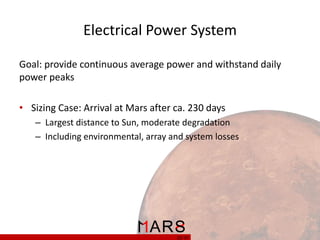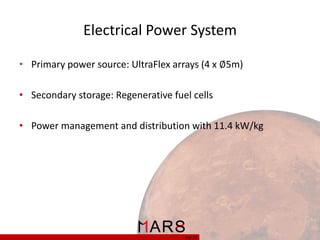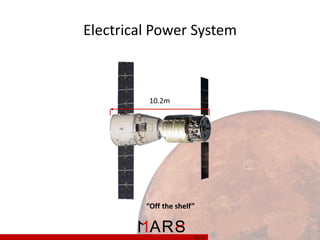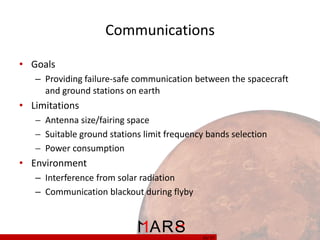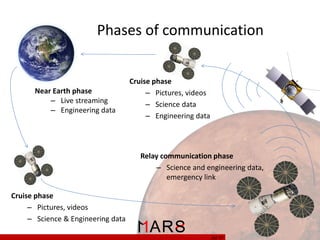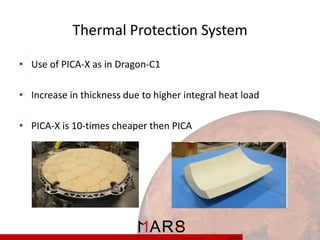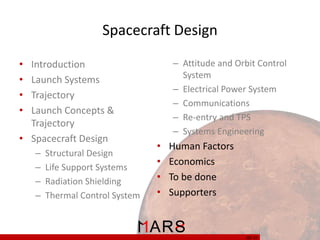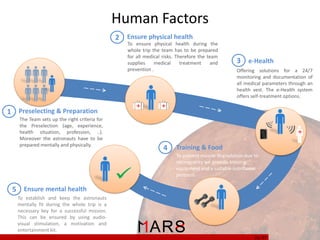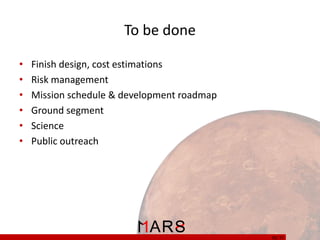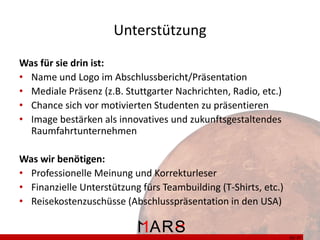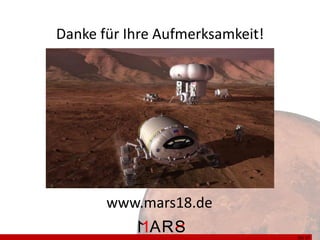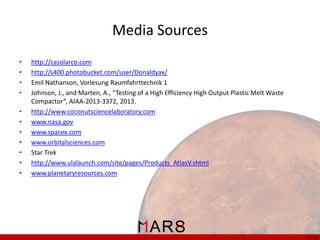Mars18-Inspiration Mars Contest - Published PDR
- 1. Preliminary Design Review - Mars18 - The Mars Society International Student Design Competition
- 2. Content тАУ Attitude and Orbit Control System тАУ Electrical Power System тАУ Communications тАУ Re-entry and TPS тАУ Systems Engineering тАв тАв тАв тАв Introduction Launch Systems Trajectory Launch Concepts & Trajectory тАв Spacecraft Design тАУ тАУ тАУ тАУ Structural Design Life Support Systems Radiation Shielding Thermal Control System тАв тАв тАв тАв Human Factors Economics To be done Supporters
- 3. Introduction The Mars Society International Student Design Competition: тАЬDesign a two-person Mars flyby mission for 2018 as cheaply, safely and simply as possibleтАЭ Phase 0/A/B Study 3/ 37
- 4. Introduction тАв Pushing the envelope towards human Mars exploration тАв Gaining public attention and generating public interest for manned space missions тАв Prepare students for future development projects with comparable goals Schedule Cost тАв Selection criteria 20% 30% Simplicity 20% Technical Quality 30% 4/ 37
- 5. Team тАв Over 40 students from aerospace engineering, economics, medicine and others in the 1st to 9th semester тАв Faculty advisors from the Institute of Space Systems 5/ 37
- 6. Requirements тАв Defined mission statement and top-level objectives тАв Derived requirements on system and subsystem level ID TL.1 TL.2 TL.3 TL.4 6/ 37 Description The mission shall be executed by two astronauts. The mission objective is to complete a mars flyby and safely return to earth. The mission will commence in the year 2018. The mission shall result in scientific progress.
- 7. Schedule тАв Critical Design Review: 14.02.2014 тАв Mars18 Deadline (Design Freeze): 28.02.2014 тАв Final Report: 14.03.2014 7/ 37
- 8. Launch Concepts Concept Cost Mio $ Date of first launch 1 (Atlas HLV based) 596,5 Sept. 2017 2 (SpaceX based) 416,5 Sept. 2017 690 Nov. 2017 586,5 Aug. 2017 Inspiration Mars Concept Cost in Mio$ Date of first launch Space Launch System & Commercial Crew Launcher 600-2100 Dec. 2017 3 (Atlas V551 based) 4 (Conservative) Comparison: 8/ 37
- 9. Concept 2 (SpaceX based) to Mars Trans-Mars-Injection (TMI) Sept. 2017 Dez. 2017 9/ 37 Dez. 2017 04. Jan. 2018
- 10. Trajectory Start orbit Start date 04.01.2018 Arrival date 19.05.2019 Duration Departure 350 x 350 km 1.37 years Capture 10/ 37 Flyby
- 11. Spacecraft Design тАУ Attitude and Orbit Control System тАУ Electrical Power System тАУ Communications тАУ Re-entry and TPS тАУ Systems Engineering тАв тАв тАв тАв Introduction Launch Systems Trajectory Launch Concepts & Trajectory тАв Spacecraft Design тАУ тАУ тАУ тАУ Structural Design Life Support Systems Radiation Shielding Thermal Control System 11/ 37 тАв тАв тАв тАв Human Factors Economics To be done Supporters
- 12. Structural Design тАв Baseline: sufficient space, simple and inexpensive deployment, support of all required structures Conservative Designs Advanced Designs 12/ 37
- 13. Structural Design Conservative Design + Costs and risks + Availability + Proven Design яАн Less spacious (but above tolerable limit by NASA Standards) яАн Modifications required 13/ 37
- 14. Structural Design тАв Sizing structure for launch and re-entry loads тАУ Peak bending moment and compressive force тАв Addition of supportive structure тАУ Secondary (e.g. International Standard Payload Racks) тАУ Docking adapters тАв Utilizing proven materials (Aluminum, Titanium) 14/ 37
- 15. ECLSS тАУ Environment Control and Life Support System Recycling of most resources (almost closed system) Urine Water Management H2O Air Management O2 Waste Water CO2 Water Management Air Management Food Feces Storage Hygiene Products Storage Waste Clothes 15/ 37
- 16. Open Loop <тАУ> Closed Loop Equivalent System Mass (ESM) [kg] 10000 9000 Closed System (VPCAR) 8000 Closed System (MF+VCD) 7000 Open System 6000 - 5500kg 5000 4000 - 1300kg 3000 2000 1000 0 100 200 300 Mission Duration [d] 16/ 37 400 500
- 17. Dirty Laundry Waste ECLSS тАУ Eating and Waste Eating simple!?! Waste Compactor Waste W a t e r Shielding tile Water System 17/ 37
- 18. Radiation Protection against SPEs SPE (detected by sensors) diverse materials Alignment towards sun ├Ш: 2 m water/feces water (decreasing) + tiles (increasing) Trunk Dragon Cygnus Trunk тАв Water gets replaced by feces to maintain shielding against SPEs тАв Amifostin is dispensed after SPE 18/ 37
- 19. Thermal Control System тАв Dissipative and external heat sources Critical Points: тАв Assembly in Earth orbit тАв Passing Venus orbit тАв Mars flyby 19/ 37
- 20. Thermal Control System 20/ 37
- 21. Attitude & Orbit Control System тАв Control system consisting of тАУ Hydrazine thrusters [orbit] тАУ Momentum wheels [attitude] тАУ Resistojets [desaturation] тАв Sensor system consisting of тАУ Sun sensors, star trackers тАУ Inertial measurement units тАУ GPS [Rendezvous] 21/ 37
- 22. Electrical Power System Goal: provide continuous average power and withstand daily power peaks тАв Sizing Case: Arrival at Mars after ca. 230 days тАУ Largest distance to Sun, moderate degradation тАУ Including environmental, array and system losses 22/ 37
- 23. Electrical Power System тАв Primary power source: UltraFlex arrays (4 x тИЕ5m) тАв Secondary storage: Regenerative fuel cells тАв Power management and distribution with 11.4 kW/kg 23/ 37
- 24. Electrical Power System 10.2m тАЬOff the shelfтАЭ 24/ 37
- 25. Communications тАв Goals тАУ Providing failure-safe communication between the spacecraft and ground stations on earth тАв Limitations яАн Antenna size/fairing space яАн Suitable ground stations limit frequency bands selection яАн Power consumption тАв Environment тАУ Interference from solar radiation тАУ Communication blackout during flyby 25/ 37
- 26. Phases of communication Near Earth phase тАУ Live streaming тАУ Engineering data Cruise phase тАУ Pictures, videos тАУ Science data тАУ Engineering data Relay communication phase тАУ Science and engineering data, emergency link Cruise phase тАУ Pictures, videos тАУ Science & Engineering data 26/ 37
- 27. Re-entry тАв 3 passes through atmosphere before re-entering тАв Keep the load factors within a limit of 5 g тАв Lower heat flux peaks 27/ 37
- 28. Thermal Protection System тАв Use of PICA-X as in Dragon-C1 тАв Increase in thickness due to higher integral heat load тАв PICA-X is 10-times cheaper then PICA 28/ 37
- 29. Systems Engineering тАв Mass, volume and power budgets тАУ Pressurized, unpressurized and packed volume тАУ Average, peak and waste power тАв Element margins depending on technology readiness level and amount of required modifications тАУ 5%, 10% and 20% 29/ 37
- 30. Spacecraft Design тАУ Attitude and Orbit Control System тАУ Electrical Power System тАУ Communications тАУ Re-entry and TPS тАУ Systems Engineering тАв тАв тАв тАв Introduction Launch Systems Trajectory Launch Concepts & Trajectory тАв Spacecraft Design тАУ тАУ тАУ тАУ Structural Design Life Support Systems Radiation Shielding Thermal Control System тАв тАв тАв тАв Human Factors Economics To be done Supporters 30/ 37
- 31. Human Factors 2 Ensure physical health To ensure physical health during the whole trip the team has to be prepared for all medical risks. Therefore the team supplies medical treatment and prevention . 3 e-Health Offering solutions for a 24/7 monitoring and documentation of all medical parameters through an health vest. The e-Health system offers self-treatment options. 1 Preselecting & Preparation The Team sets up the right criteria for the Preselection (age, experience, health situation, profession, ..). Moreover the astronauts have to be prepared mentally and physically. 4 Training & Food To prevent muscle degradation due to microgravity we provide training equipment and a suitable nutritional protocol. 5 Ensure mental health To establish and keep the astronauts mentally fit during the whole trip is a necessary key for a successful mission. This can be ensured by using audiovisual stimulation, a motivation and entertainment kit. 31/ 37
- 32. Economics - Cost estimating methods тАв Parametric: mathematical equations relating cost to one or more physical or performance variables associated with the item being estimated тАв Build-up: historical data (e.g. detailed work hours and bills of material) тАв Analogy: the data is adjusted or extrapolated 32/ 37
- 33. To be done тАв тАв тАв тАв тАв тАв Finish design, cost estimations Risk management Mission schedule & development roadmap Ground segment Science Public outreach 33/ 37
- 34. Supporters тАв тАв тАв тАв тАв тАв Institut f├╝r Raumfahrtsysteme тАУ Uni Stuttgart ASTOS Solutions тАУ Bahnbestimmung und -optimierung Campus Konzept Stuttgart тАУ Studentische Unternehmensberatung Constellation тАУ Studentische Nachwuchsforschungsgruppe DGLR тАУ Stuttgart BrainLight GmbH тАУ Marktf├╝hrer f├╝r Entspannungstechnologie 34/ 37
- 35. Unterst├╝tzung Was f├╝r sie drin ist: тАв Name und Logo im Abschlussbericht/Pr├дsentation тАв Mediale Pr├дsenz (z.B. Stuttgarter Nachrichten, Radio, etc.) тАв Chance sich vor motivierten Studenten zu pr├дsentieren тАв Image best├дrken als innovatives und zukunftsgestaltendes Raumfahrtunternehmen Was wir ben├╢tigen: тАв Professionelle Meinung und Korrekturleser тАв Finanzielle Unterst├╝tzung f├╝rs Teambuilding (T-Shirts, etc.) тАв Reisekostenzusch├╝sse (Abschlusspr├дsentation in den USA) 35/ 37
- 36. Danke f├╝r Ihre Aufmerksamkeit! www.mars18.de 36/ 37
- 37. Media Sources тАв тАв тАв тАв тАв тАв тАв тАв тАв тАв тАв http://casolarco.com http://s400.photobucket.com/user/Donaldyax/ Emil Nathanson, Vorlesung Raumfahrttechnik 1 Johnson, J., and Marten, A., тАЬTesting of a High Efficiency High Output Plastic Melt Waste CompactorтАЭ, AIAA-2013-3372, 2013. http://www.coconutsciencelaboratory.com www.nasa.gov www.spacex.com www.orbitalsciences.com Star Trek http://www.ulalaunch.com/site/pages/Products_AtlasV.shtml www.planetaryresources.com 37/ 37

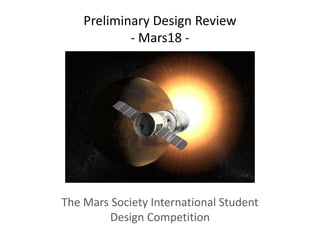
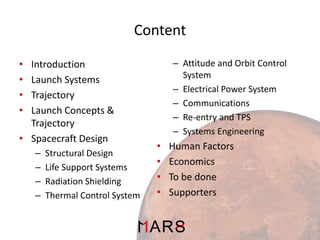
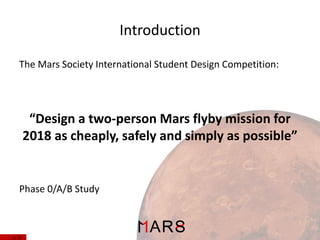
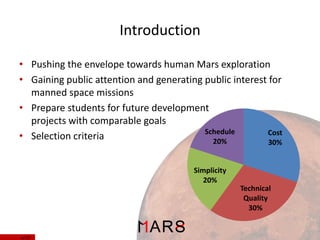
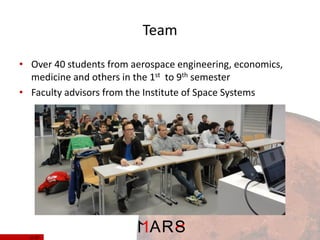
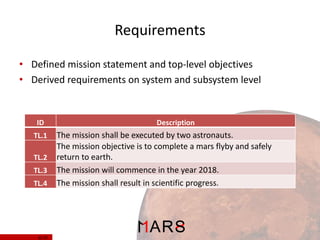
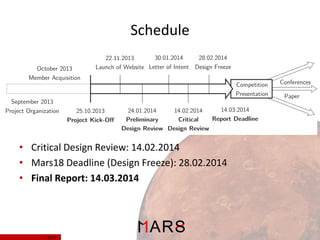
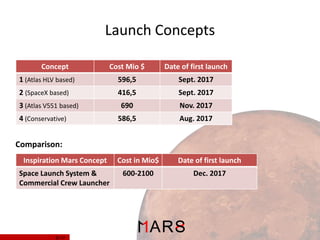

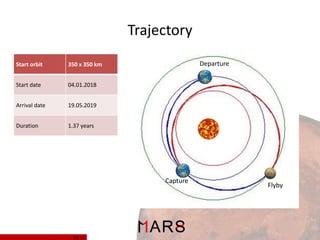
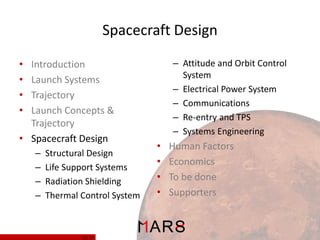
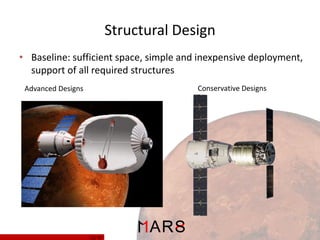
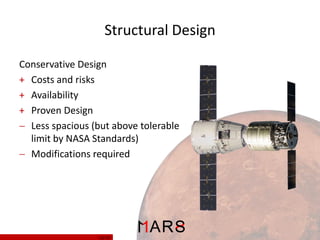


![Open Loop <тАУ> Closed Loop
Equivalent System Mass (ESM) [kg]
10000
9000
Closed System (VPCAR)
8000
Closed System (MF+VCD)
7000
Open System
6000
- 5500kg
5000
4000
- 1300kg
3000
2000
1000
0
100
200
300
Mission Duration [d]
16/ 37
400
500](https://image.slidesharecdn.com/20140128-pdrv6publish-140211050439-phpapp02/85/Mars18-Inspiration-Mars-Contest-Published-PDR-16-320.jpg)
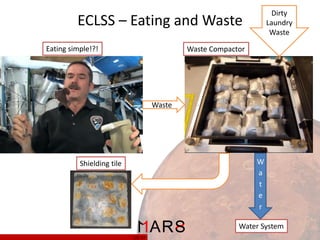

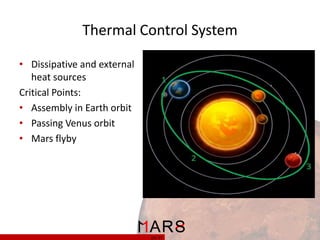
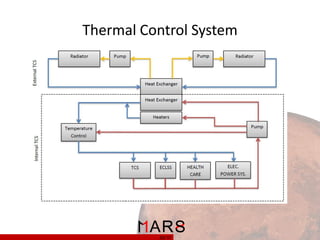
![Attitude & Orbit Control System
тАв Control system consisting of
тАУ Hydrazine thrusters [orbit]
тАУ Momentum wheels [attitude]
тАУ Resistojets [desaturation]
тАв Sensor system consisting of
тАУ Sun sensors, star trackers
тАУ Inertial measurement units
тАУ GPS [Rendezvous]
21/ 37](https://image.slidesharecdn.com/20140128-pdrv6publish-140211050439-phpapp02/85/Mars18-Inspiration-Mars-Contest-Published-PDR-21-320.jpg)
